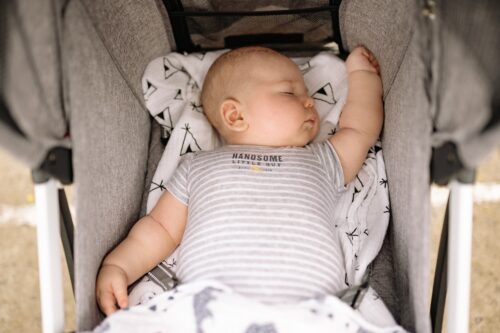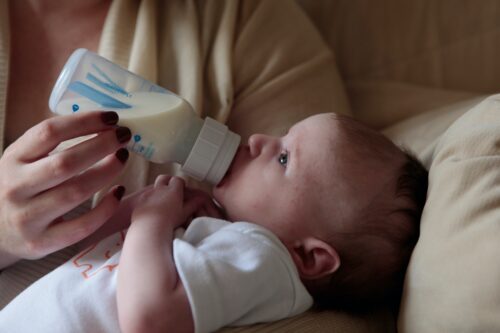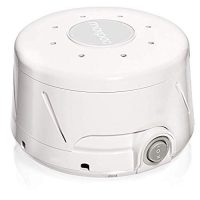All parents have been there. You finally get the baby down for a nap, finish up what you need to around the house, but as soon as you sit down to have some time to yourself…you hear that dreaded cry. Naptime is over. We all need a naptime break for ourselves, and our babies need it to grow. Hopefully, our tips to get your baby to nap longer can improve both your and your baby’s day.
Use a Sound Machine
Sound machines are a great tool for getting baby to sleep and keeping baby asleep. For newborns, white noise mimics the familiar whooshing sound they were used to hearing in the womb. For older babies, a sound machine provides a calming sound and serves as a cue that it is time to go to bed.
If babies are used to hearing the sound machine each time that it is time for them to sleep, their brains will start to associate the sound with sleeping time. This helps with putting babies down for a nap, but also for extending their nap. If they wake up before nap time is over, hearing the sound machine can cue them that it is still time to sleep and keep them from fully waking up.
Also, sound machines can block out sound from around the house. During the day, there may be more going on in the house than at night, so a sound machine will help block out older children playing, the dog barking, the doorbell ringing, or other daytime interruptions.
The Hatch Baby Rest Sound Machine is my favorite because of all of the settings and the ability to control it from your phone. It also lights up and can become an “ok to wake” clock, to help with longer naps for toddlers. The Yogasleep Rohm White Noise Machine is another white noise machine that I love. It is more affordable than the Hatch and great for travel.
Keep the Room Dark
Naps happen during the daytime, which means that it is possible the sun is shining right into your baby’s room. If your baby isn’t napping long, check out how bright it is in the room during their nap. Sunlight tells our brains that it is time to be awake. Even though babies cannot be awake all day (or shouldn’t be), the sunlight may be telling their brain that they should be.
If the sun starts to shine right on your baby in the middle of their nap, it will be hard for them to sleep through it. A dark room will tell their brain that it is time to sleep, which will help for going to sleep and staying asleep. If you want your baby to nap longer, make sure their room is as dark as you can make it. It should be almost as dark as it is at night.
Blackout shades/curtains can be a great solution for this. Many curtains are sold as “room darkening” but sometimes even those do not do the job. My favorite blackout shades are these Redi Shade Paper Shades that you can stick right on the window. If you have curtains, you can pull the curtains closed in front of them and no one will even know they are there.
Now if your baby starts sleeping too long and then not sleeping well at night, consider pulling the shades during the day just enough to dim the light but not completely block it out. You don’t want to confuse your child’s circadian rhythm!
Use a Swaddle or Sleepsack
If your baby is younger and not yet rolling, try swaddling them during their nap. Swaddles keep the baby’s startle reflex from waking them up. A tight swaddle such as the HALO Sleepsack Swaddle can help extend their nap. If your baby is older or does not love the swaddle, try out the Merlin’s Magic Sleepsuit to help control this startle reflex and help them nap longer.
When your baby starts to roll, they can no longer be swaddled or in a sleepsuit. At this point, their startle reflex should be going away, but a sleep sack can still be helpful. Putting your baby in their sleep sack for a nap can become a cue for them to know that it is time to sleep. This can help with your baby being able to fall asleep and stay asleep longer.
The sleep sack can also be a way to keep them warm and cozy during their naps since babies under 12 months should not use blankets. Many times babies are not dressed the same during naps as they are for sleep. Make sure that what they are wearing for their nap is not too cool or too hot. Also, check that what they are wearing is safe and comfortable. Jeans may be super cute on babies, but they are not the most comfortable to sleep in. Check out our favorite sleep sacks here.
Watch Wake Windows

Something crucial to pay attention to when it comes to naps is what is called “wake windows”. This is how long your baby should be awake before needing to go down for a nap. If your baby has not been up for very long, they may not be tired enough to take a full long nap. If your baby has been awake for too long, they may be overtired. Under and over-tiredness can lead to shortened naps.
During the baby’s awake time, make sure they are being stimulated in order for that tiredness to build up. Take them for a walk outside or on a grocery run. Allow them to have tummy time and sensory experiences.
Wake windows vary by age and by the child. The wake window is the amount of time that your baby should be awake before taking a nap, in order to be tired enough to take a full nap. Here are some general wake windows for babies:
1-3 months: 1 to 1.5 hours
3-4 months: 1.5 to 2 hours
5-6 months: 2 to 3 hours
7-14 months: 3 to 4 hours
14-24 months: 4 to 6 hours
As you can see, there is a range at each age, so you may have to try out different wake windows for your child to see what works. If their naps are short and they are on the shorter end of the wake window, try giving them 15 minutes more of awake time and see how it goes. If they are at the longer end of the wake window, try putting them down a bit earlier and see how the nap is affected. It may take some trial and error, but it will be worth it for longer naps!
Pay Attention to Sleep Cues

Is your baby rubbing his or her eyes, yawning, staring off into the distance, or starting to fuss? These may be signs that they are tired. If you notice these cues, it is probably time for a nap. Waiting too long past these cues may cause your baby to be overtired. If you think your baby may be overtired, check out our tips on how to get a baby to sleep when overtired.
If you are not noticing any of these cues, your baby may not be tired enough for a good nap.
Allow Your Baby to Fall Asleep Independently

If your baby can fall asleep independently for their nap, they are more likely to stay asleep and nap longer. If you are rocking or feeding them to sleep, it is more likely that they will wake up. Once their body is no longer in a deep sleep, they will realize that whatever they fell asleep with (rocking or eating) is no longer there and may want it to be able to go back to sleep.
If the baby fell asleep on their own, they are more likely to be able to put themselves back to sleep on their own if their nap is disturbed.
Getting your baby to fall asleep independently is a whole other ballpark, but it is definitely possible and can help with naps. If your baby is over 6 months, you may want to look into sleep training methods if you are interested.
Avoid Catnaps Outside of Crib

If your baby falls asleep in the car/stroller or after nursing/bottle for just 10-15 minutes, it may make it harder for them to nap. Even this small amount of sleep will recharge them just enough to make napping more difficult.
If falling asleep in the car seat is a struggle, try to play upbeat music or give them toys to keep them awake. If someone else is driving, you can try to sit next to them to keep them active and awake.
Stroller naps can be avoided by interacting and talking with your baby while you walk. Once your baby can hold their head up well, allow your baby to sit more upright and face out in their stroller if your stroller allows for it.
Keep them awake during breast/bottle feedings by undressing them down to a diaper, or singing to them. It also helps to try to feed them soon after they wake up from a nap so that they will be more alert and awake and ingest a full feeding.
Cribs are usually the best place for babies to take naps so if you are struggling to get your baby to sleep in their crib, check out how to get your baby to sleep in a crib.
Conquer Night Sleep

If your baby is not sleeping well at night, they most likely will not nap well either. If they are not getting enough sleep at night, they may be too tired to nap well. It is important to conquer night sleep before working on naps. If you need help with this, check out how to get your baby to sleep until 7 am.
On the other hand, if they are sleeping too much at night (over 12 hours) that may contribute to short naps as well.
Consider Baby’s Feeding Schedule

Although it is not usually the case, you do want to make sure that your baby is not waking up because they are hungry. Babies should be fed every 2.5-3 hours. If it has been over 2 hours since your baby’s last feeding, you may want to feed them again before their nap so that they do not wake up due to hunger.
You also want to try to make sure your baby is getting full feedings. If your baby tends to snack by having only an ounce or so every hour or breastfeeding frequently for short amounts of time, it may be harder for them to take a longer nap.
Drop a Nap

If your baby is around 4 months, 7 months, or 14 months and is having short naps, it may be time to drop a nap. Around 4 months, babies tend to drop from 4 naps to 3 naps. Try stretching the wake windows a bit longer so that your baby only takes 3 naps, and see if those naps get longer. This is the same case with 3 to 2 naps at around 7 months and 2 to 1 nap at 14 months.
Create a Naptime Routine

Make sure that your baby has some sort of naptime routine. If you are putting them right in the crib and walking away, their bodies may not be quite ready for sleep. Use some of the tips above to create a routine and nap environment. Turn off the lights, turn on the sound machine, and put them in their sleep sack. Then maybe sing a song, read a quick book, or rock for a bit to cue their brain that it is time for sleep.
Help Them Out

Small babies are still learning how to sleep, so there is nothing wrong with going in and trying to get them to go back to sleep if they wake up 20 minutes into a nap. They need that sleep! You can give them a pacifier if they take one or place a hand on their tummy to relax them. Try making a shushing noise and possibly rocking their body a bit with that hand on their tummy.
If they still won’t calm down, you can take them out of the crib and try to rock them back to sleep. We know that rocking to sleep can cause babies to rely on that rocking motion for sleep but doing it every so often to get those extra 30 minutes won’t hurt.
FAQs about Baby Naps
When will my baby start taking longer naps?
Newborn babies under 4-6 weeks will likely not have a consistent nap schedule. At this point in time, babies will most likely spend much of their day sleeping and eating. Worrying about extending naps is not appropriate at this stage.
If your baby is under 5 months old, these tips can still be helpful, but it is important to remember that it is considered developmentally appropriate for babies to take short naps before 5 months old. If you are trying all of these tips and your baby is under 5 months and still not napping long, you may just need to wait until they get older. Their brains and bodies are still developing and learning how to sleep.
How many naps should my baby take?
With younger babies, it is more important to follow wake windows rather than a set schedule. This means that the number of naps your baby takes may vary, especially if they take shorter naps. On average, here are the number of naps that a baby should take a day based on their age:
1-4 months: 4 naps
4-7 months: 3 naps
7-14 months: 2 naps
14+ months: 1 nap
How long should my baby nap for?
A typical sleep cycle for a baby can be anywhere between 45 minutes and 2 hours. Most babies do not nap for longer than 2 hours. An average nap for a baby is around 1.5 hours. Their naps may differ throughout the day as well. They may nap for 1.5 hours in the morning, but only 1 hour in the afternoon. Once they are down to 1 nap which is usually around 12 months or later, they may nap for 2-3 hours.
Their naps may also differ based on their night sleep. Babies under 12 months should sleep 12-16 hours per 24 hours. If they sleep longer at night, they may take shorter naps, and vice versa.
Can my baby nap on me?
Yes! If that works for you, soak in those cuddles. Some babies can take their longest naps on their parents, while others may wake up at any disturbance. Just make sure to stay awake and alert for safe sleep.
Wrap Up
There are many different strategies to use to try to get your baby to nap longer. My best advice would be to pick one and try it for a week. If a certain technique is not working after a week, add another strategy or move on to a different one. Here is a quick list of tips from above:
- Use a sound machine
- Keep the room dark
- Use a swaddle/sleep sack
- Watch wake windows
- Allow baby to fall asleep independently
- Avoid catnaps outside of the crib
- Pay attention to sleep cues
- Conquer night sleep
- Consider baby’s feeding schedule
- Drop a nap
- Create a naptime routine
- Help them out
If you have tried these solutions and are still struggling, hang in there. Remember that it is developmentally normal for young babies to take short naps and that their naps may improve with age.









